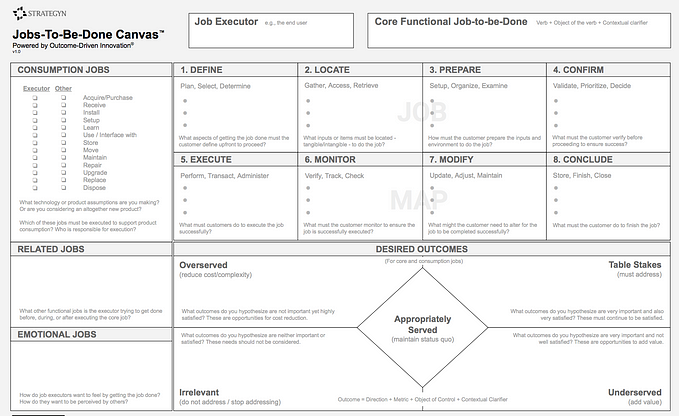Inventing the Perfect Customer Need Statement
Innovation is the process of devising a solution that addresses unmet customer needs. To win at innovation, a company must be able to uncover all the customers’ needs, figure out which are unmet and then work to devise solutions that will address them.
Sounds simple enough, but in most companies the marketing, development, and R&D teams can’t even agree on what a “need” is. This is the root cause of failure in innovation. While customer needs are a critical input into the innovation process, confusion as to what a need is continues to derail the science of needs discovery.

To address this issue, the Strategyn team and I have spent nearly three decades working on inventing the “perfect” need statement. This has resulted in the creation of the desired outcome statement, which is the cornerstone of Strategyn’s Outcome-Driven Innovation process.
To invent the perfect need statement we started by asking, “what characteristics should a need statement possess in order to make it the perfect input into the innovation process?” My team and I have concluded that the perfect set of need statements should possess these 10 characteristics:
1. Stable over time: It’s hard to hit a moving target. The ideal set of needs would not change from the beginning to the end of the product development cycle, or for the foreseeable future. If needs are ever-changing then innovation will always be a guessing game dependent on luck. A need must be a constant (not a variable) in the innovation equation.
2. Reveal how customers measure value: The perfect set of need statements would communicate the metrics that customers use to measure value. If customer value can be measured, then the ability to create that value becomes more predictable.

3. Enable the accurate evaluation of competing solutions: The ideal set of customer needs would enable a company to successfully predict what products/services will win in the marketplace. By evaluating competing solutions and ideas/concepts for new offerings against a complete set of needs, a company should be able to determine which solution will appeal most to customers.
4. Guide the creation of a new products/services: The perfect need statements would be actionable, meaning they would be measurable and controllable in the design of a product or service offering. In other words, the need statements would describe what function the product/service should offer to improve performance and guide the creation of valuable ideas/solutions.
5. Prevent misunderstanding: The perfect set of needs would be clear, concise, accurate and stated in a way that could not be misunderstood, misinterpreted or misused. The statements would not be ambiguous. Everyone in the organization would have the same understanding of the customer’s needs.
6. Explain all the causal factors that contribute to failure: The innovation process is unpredictable when companies don’t know all the factors that contribute to process variability. The ideal set of needs would reveal all the metrics/criteria that customers use to assess the value one product/service offering provides over another. Knowing these metrics/criteria would help companies predict what products and services will win in the marketplace.
7. Discoverable through research: Ideally, the need statements would be easily obtainable in a consistent format from customers or other sources in a reproducible and scalable manner.
8. Enable unmet need discovery: Knowing which of the customer’s needs are unmet is fundamental to success at innovation. Consequently, the need statements would have to be structured so that customers could prioritize them in a way that reveals which are unmet.
9. Inform the organization: The perfect set of need statements would help each function get its job done better. For example, it would help marketing define a more effective value proposition; help product planning identify hidden opportunities; help M&A better determine what acquisitions would fill gaps in the product line; help R&D effectively determine where to invest, and so on.
10. Unify the organization: Ideally, one set of need statements would inform the entire organization, including sales, marketing, product planning, strategy, development, R&D, M&A and other company functions. Rather than nobody knowing all the customer’s needs, the entire organization would know and agree on a common set of customer needs. This would unite the organization in its language, market understanding and direction.
Desired outcome statements were designed to possess these characteristics and more. Built on Jobs-to-be-Done Theory, desired outcomes are “the metrics customers use to measure success when getting a job done”, making them stable over time. When the job is the stable unit of analysis, value is defined by helping customers get the job done better.
One desired outcome associated with the job of “listening to music” is:

You can see that this statement is devoid of solutions, measurable, controllable, unambiguous and guides the creation of customer value. To learn more about desired outcome statements and the Outcome-Driven Innovation process see the Outcome-Driven Innovation whitepaper.
Learn more: download a FREE PDF or AUDIO version of my latest Jobs-to-be-Done book, JOBS TO BE DONE: Theory to Practice.

In addition, you can now access ODIpro, our online innovation strategy platform, where you can:
- Get certified in putting Jobs Theory and Outcome-Driven Innovation (ODI) into practice.
- Apply the process to your markets using Strategyn’s latest tools and templates.
- Align your team around a winning product strategy.
To learn more about Strategyn’s consulting offerings and customized programs for innovation, go to Strategyn.com.










